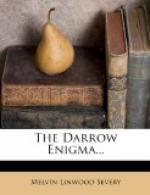“Here, for example,” he said, taking up a small slip of glass which he had cut from the eastern parlour window of the Darrow house, “is something I have never shown either you or Miss Darrow. It is utterly worthless, so far as assisting us to track the assassin is concerned, but, if ever we suspect the right man, the evidence on that glass would probably convict him, though there were ten thousand other suspects.”
I took the glass from him and, examining it with the utmost care, I detected a smutch of yellowish paint upon it, nothing more. “For Heaven’s sake, Maitland!” I said in astonishment, “of what possible use can that formless daub of paint be, or is there something else on the glass that has escaped me?” He laughed at my excitement as he replied:
“There is nothing there but the paint spot. Regarding that, however, you have come to a very natural though erroneous conclusion. It is not formless”; and he passed me a jeweller’s eye-glass to assist me in a closer examination. He was right. The paint lay upon the glass in little irregular furrows which arranged themselves concentrically about a central oval groove somewhat imperfect in shape. “Well,” continued. Maitland, as I returned him the magnifying glass, “what do you make of it?” “If you hadn’t already attached so much importance to the thing,” I said, “I should pronounce it a daub of paint transferred to the glass by somebody’s thumb, but, as such a thing would be clearly useless, I am at a loss to know what it is.”
“Well,” he rejoined, “you’ve hit the nail on the head,—that’s just what it is, but you are entirely wrong in your assumption that the thumb-mark can have no value as evidence. Do you not know that there are no two thumbs in the world which are capable of making indistinguishable marks?” I was not aware of this. “How do you know,” I asked, “that this mark was made by the assassin? It seems to me there can hardly be a doubt that one of the painters, while priming the sill, accidentally pressed his thumb against the glass. His hands would naturally have been painty, and this impression would as naturally have resulted.”
“What you say,” replied Maitland, “is very good, so far as it goes. My reasons for believing this thumb-mark was made by the assassin are easily understood. First: there was another impression of a thumb in the moist paint of the sill directly under that upon the glass. Both marks were made by the same thumb and, in the lower one, the microscope revealed minute traces of gravel dust, not elsewhere discernible upon the sill. The thumb carried the dust there, and was the thumb of the hand pressed into the gravel,—the hand of which I have a cast. You see how this shows how the thumb came to have paint upon it when pressed upon the glass. Second: the two men engaged in priming the house, James Cogan and Charles Rice, were the only persons save the assassin known to have been upon that side of the house the day of the murder. “Here,” he said, carefully removing two strips of glass from a box, “are the thumb-marks of Cogan and Rice made with the same paint. You see that neither of these men could, by any possibility, have made the mark upon the glass. So there you are. But we are missing the question before us. What line of procedure can you suggest, Doc? I’m all at sea.”




